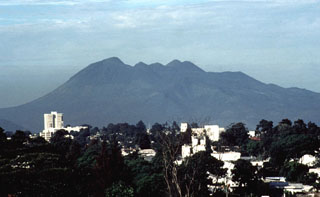Report on Pacaya (Guatemala) — 26 May-1 June 2010
Smithsonian Institution / US Geological Survey
Weekly Volcanic Activity Report, 26 May-1 June 2010
Managing Editor: Sally Sennert.
Please cite this report as:
Global Volcanism Program, 2010. Report on Pacaya (Guatemala) (Sennert, S, ed.). Weekly Volcanic Activity Report, 26 May-1 June 2010. Smithsonian Institution and US Geological Survey.
Pacaya
Guatemala
14.382°N, 90.601°W; summit elev. 2569 m
All times are local (unless otherwise noted)
A Strombolian eruption from Pacaya's MacKenney cone that began on 27 May was characterized in a report from CONRED as having constant explosions that ejected material 500 m into the air. Ash plumes rose 1.5 km above the crater and drifted W and SW, causing ashfall in multiple areas. The community of El Patrocinio (about 5 km W) evacuated and residents in El Rodeo (4 km WSW) were ordered to evacuate. Due to extensive tephra fall, authorities recommended that residents clean off ash from their roofs and refrain from driving.
INSIVUMEH reported a continuing series of explosions 5-10 seconds apart that ejected black ash up to 1 km above the crater on 28 May. Seismic signals reflected the explosions in addition to tremor. Ash plumes drifted 20-30 km NW, causing ashfall in areas downwind, including in Guatemala City, about 30 km NNE. CONRED reported a short time later that about 1,600 people had been evacuated from six towns 3-4 km W, NNW, N, and NNE, and that Aurora International Airport was closed. According to a map posted by CONRED, blocks fell in areas as far away as 12 km NE and ash was reported in areas E of Chinautla, 37 km NNE. News media reported that one person (a reporter) died and three children were missing.
On 29 May, a 90-m-wide lava flow that traveled SSE at an estimated rate of 100 m per hour burned three houses on the Pacaya Grande ranch. The lava was within 450 m of some other properties including El Chupadero, located 2-2.5 km S of the crater, and disrupted an access road from El Caracol (3 km SW) and Los Pocitos (5.5 km S). Explosions ejected ash 300-500 m above the crater. INSIVUMEH reported on 1 June that the Strombolian activity continued. Explosions ejected ash as high as 700 m above the crater and ash plumes drifted NW. Two lava flows were seen traveling SW and SE.
Geological Summary. Eruptions from Pacaya are frequently visible from Guatemala City, the nation's capital. This complex basaltic volcano was constructed just outside the southern topographic rim of the 14 x 16 km Pleistocene Amatitlán caldera. A cluster of dacitic lava domes occupies the southern caldera floor. The post-caldera Pacaya massif includes the older Pacaya Viejo and Cerro Grande stratovolcanoes and the currently active Mackenney stratovolcano. Collapse of Pacaya Viejo between 600 and 1,500 years ago produced a debris-avalanche deposit that extends 25 km onto the Pacific coastal plain and left an arcuate scarp inside which the modern Pacaya volcano (Mackenney cone) grew. The NW-flank Cerro Chino crater was last active in the 19th century. During the past several decades, activity has consisted of frequent Strombolian eruptions with intermittent lava flow extrusion that has partially filled in the caldera moat and covered the flanks of Mackenney cone, punctuated by occasional larger explosive eruptions that partially destroy the summit.
Sources: Coordinadora Nacional para la Reducción de Desastres (CONRED), Instituto Nacional de Sismologia, Vulcanologia, Meteorologia, e Hidrologia (INSIVUMEH), Reuters

